Sony EE34: Sony Makes Budget AMD Laptops?
by Dustin Sklavos on February 22, 2011 4:43 PM ESTBattery Life
When we get to the battery running time we also hit probably the most pleasant surprise about the Sony EE34. We're used to seeing pretty dismal battery life out of most AMD portables, and with the remarkably small battery the EE34 is equipped with (39Wh? Seriously?) the prognosis really only gets worse. So surprise surprise, the EE34 actually doesn't do half bad.
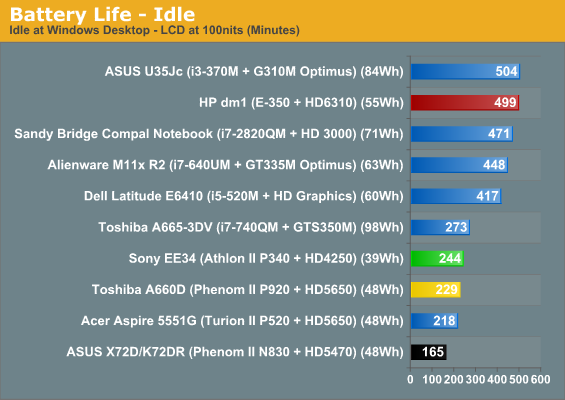
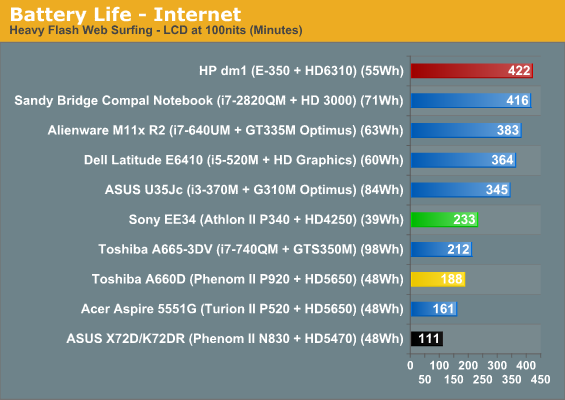
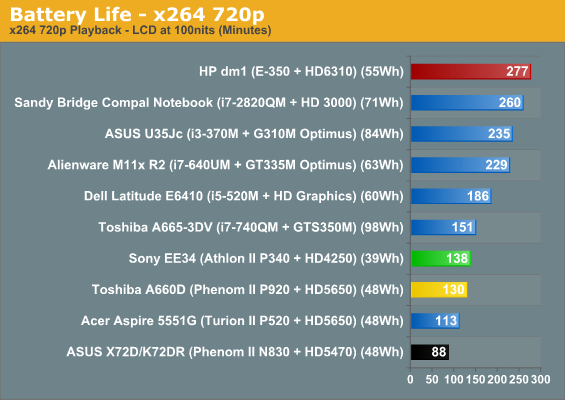
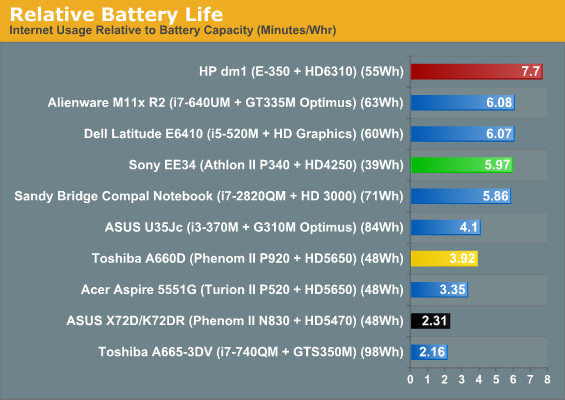
Would you look at that: the 25W Athlon II P340 is actually able to pull nearly four hours of running time while surfing the internet! Not too shabby and a long way from the dismal numbers the other AMD-based notebooks (barring the nimble HP dm1z) pull. It's still not quite enough to bring it up to the running times of the Intel machines, but if you look at the relative battery life you'll see the EE34 doing a pretty stellar job with what it has given that it ships with a battery so small a netbook would be embarassed to be caught with it.
Heat and Noise
Given the integrated graphics and reasonably low wattage processor Sony ships the EE34 with, it should come as no surprise that the notebook actually runs fairly cool and quiet.

These temperatures are actually really good. We're used to seeing AMD mobile chips run hot, but the 61C on the cores is actually frosty even by Intel mobile standards. There may not be much to cool, but what there is, the EE34 seems to do a good job of cooling it.
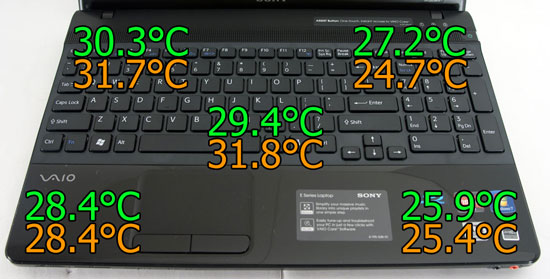
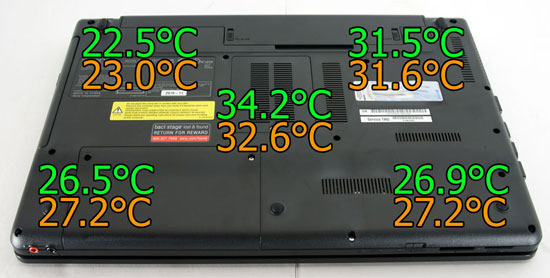
The surface temperatures of the EE34 are all pretty reasonable, with the hottest point typically being the space above the memory access panel. The cooling system actually seems to be remarkably efficient; when placed under load the fan remains very quiet but pulls a lot more heat away, resulting in parts of the notebook actually running cooler under load than idle. It's strange, but overall the EE34 remains comfortable to use and nicely inobtrusive.










52 Comments
View All Comments
rns.sr71 - Tuesday, February 22, 2011 - link
'While Llano's CPU performance doesn't promise to be a substantial improvement over what we've seen here (the cores are basically K10.5)'- now hold it. amd is doubleing l2 cache size, improving prefetchers, improving the mem. controller(hopefully efficiency), and i have to believe that they are increasing the width and/or the speed of the cpu/nb. it could outperform deneb clock for clock then factor in a REAL turbo....it could be 15-25 percent better than deneb depending on the app. 15-25 percent better than propus across the board.nitrousoxide - Tuesday, February 22, 2011 - link
While improvements may occur, there won't be substantial changes in CPU performance for it's still a 3-issue design. And note there's no way Llano can be clocked at, say, 3.0GHz (at least without Turbo) due to TDP limit (Llano should have even higher TDP than quad-core i7s because there's a discrete level GPU packed in it). So you can't really expect a Llano faster than the desktop Athlon II X4 640 today. But anyway, with four cores, it should at least keep up with low-end dual core Sandybridge and would provide much much better IGP performance. I expect the IGP performance to be at the same level of downclocked versions of Mobility 5650 (ones equipped in Toshiba and Sony laptops). That performance is enough for most gaming with high (though not ultra high) settings at 1366x768 resolution.rns.sr71 - Tuesday, February 22, 2011 - link
not tryin to argue, but look at this- http://www.legitreviews.com/article/1443/1/"Quite a lot is known about Llano processor, which is a part of Sabine platform. As reported earlier, AMD Llano accelerated processing unit (APU) will have four x86 cores based on the current micro-architecture each of which will have 9.69mm² die size (without L2 cache), a little more than 35 million transistors (without L2 cache), 2.5W – 25W power consumption, 0.8V – 1.3V voltage and target clock-speeds at over 3.0GHz clock-speed. The cores will dynamically scale their clock-speeds and voltages within the designated thermal design power in order to boost performance when a program does not require all four processing engines or trim power consumption when there is no demand for resources. According to sources familiar with the matter, different versions of Llano processor will have thermal design power varying from 20W to 59W: high-end dual-core, triple-core and quad-core chips will have TDP between 35W and 59W; mainstream chips with two of four x86 cores will fit into 30W thermal envelope and low-power dual-core Llano chips will have 20W TDP." -
rns.sr71 - Tuesday, February 22, 2011 - link
also, yes it is still 3 issue. but changes to prefetchers, OoO buffer, scheduler efficiency, ect would improve ipc noticeably. i think the doubling of the l2 cache, lower latency, higher mem bandwidth, wider/faster cpu/nb(which has to be improved) would make up for not having an l3 cache. so it could outperform a deneb. maybe by the same amount that deneb outperformed its predecessor.nitrousoxide - Wednesday, February 23, 2011 - link
IPC can only be improved with substantial architectural changes, not such minor adjustments. So you can't seriously expect too much CPU performance from Llano, but as I said, it could be as fast, if not faster than dual core sandybridge.Hrel - Tuesday, February 22, 2011 - link
I really don't care about blu ray at all, and with this kind of performance of paltry screen...I just cannot justify paying more than 400 for this laptop. Either remove the blue ray and drop the price to 500 or less or put in a nice 500:1 contrast 1080p screen with a 6 cell battery.
Hrel - Tuesday, February 22, 2011 - link
at 500 bucks with blu-ray I can see a place for it. Even a dollar more though and it's just not worth it. In 6 months every laptop on big box shelves will include Sandy Bridge IGP which greatly outperforms this in every single way. AMD really needs the ramp up their mobile offerings.mino - Tuesday, February 22, 2011 - link
One thing where it also outperforms even those Xpress 1200 IGP's of old is in driver bugs on Windows and driver non-existence on Linux.It is worth keeping that in mind. I'd take ATi Xpress 200 from 2005 over HD Graphics any day. With an SB CPU to chug along, of course ;)
MobiusStrip - Tuesday, February 22, 2011 - link
The screen doesn't matter as long is it's an asinine glossy one.The contrast ratio doesn't mean anything when the image is covered in a reflective sheen all the time. And it will be, even in a pitch-black room, because at the very least YOU will be reflected in it.
Unless you do all your computing in a ninja outfit, in a closet.
kevith - Wednesday, February 23, 2011 - link
Haha, great:-)